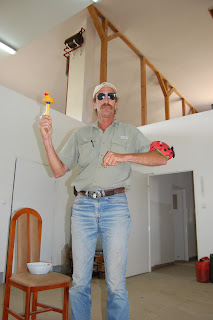
As the 4th greensite looked upon my arrival at the end of April 2007. The green was originally sited close to the forest which is just outside the left edge of this photo. The green was moved significantly to the right so it would get morning sunlight in the summer and more importantly, in the winter. If it had remained left, the green would have been a struggle to maintain, and been closed most of the winter.

Peat was found where the green was moved. It was about 1meter deep, and was excavated. In the process, and 8inch (20cm) pipe was broken. Rain soon followed, and a nice size pond formed. For a while the idea of an island green between the ponds (to the right of the one in this photo) was entertained. The green would have been smallish, had a lot of chipping area, and been surrounded by sand. It would have been a short, risk-reward par-5 of some 460 meters (500 yards). See Conceptual Illustrations at the bottom of this post.

The buffer wall, almost 7-meters high behind the green, not long after the fill was stockpiled. Fill came from the excavation of a nearby lake.

Today. The drainage problem was solved, the area capped with about 2-meters of sand. The green has been shaped and floated out. There is still some work to go. The hill behind hasn't been shaped as it will be heavily planted with bush.

The following is a small set of basic conceptual illustrations for the Island Green Concept. The green would have been surrounded by a fairly large chipping areas and buffered by sand that transitioned into wetland and water. The direct line of play is directly over the water (second sketch illustrates this), the alternate, 3-shot route comes from the left at a 20 to 30% angle. They're presented in the order they were sketched.





Tony Ristola
agolfarchitect.com
+1(909) 581 0080























